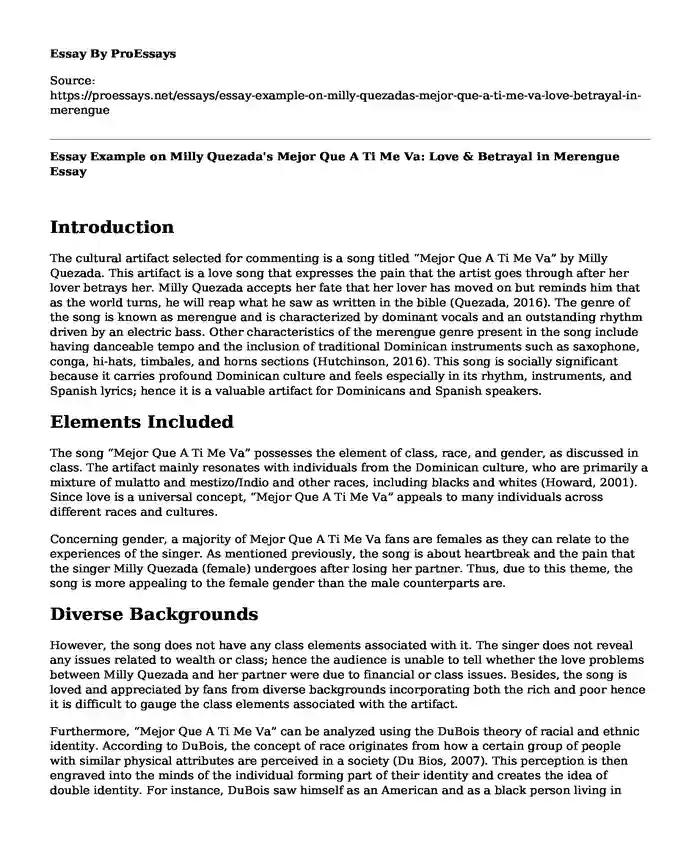Introduction
The cultural artifact selected for commenting is a song titled “Mejor Que A Ti Me Va” by Milly Quezada. This artifact is a love song that expresses the pain that the artist goes through after her lover betrays her. Milly Quezada accepts her fate that her lover has moved on but reminds him that as the world turns, he will reap what he saw as written in the bible (Quezada, 2016). The genre of the song is known as merengue and is characterized by dominant vocals and an outstanding rhythm driven by an electric bass. Other characteristics of the merengue genre present in the song include having danceable tempo and the inclusion of traditional Dominican instruments such as saxophone, conga, hi-hats, timbales, and horns sections (Hutchinson, 2016). This song is socially significant because it carries profound Dominican culture and feels especially in its rhythm, instruments, and Spanish lyrics; hence it is a valuable artifact for Dominicans and Spanish speakers.
Elements Included
The song “Mejor Que A Ti Me Va” possesses the element of class, race, and gender, as discussed in class. The artifact mainly resonates with individuals from the Dominican culture, who are primarily a mixture of mulatto and mestizo/Indio and other races, including blacks and whites (Howard, 2001). Since love is a universal concept, “Mejor Que A Ti Me Va” appeals to many individuals across different races and cultures.
Concerning gender, a majority of Mejor Que A Ti Me Va fans are females as they can relate to the experiences of the singer. As mentioned previously, the song is about heartbreak and the pain that the singer Milly Quezada (female) undergoes after losing her partner. Thus, due to this theme, the song is more appealing to the female gender than the male counterparts are.
Diverse Backgrounds
However, the song does not have any class elements associated with it. The singer does not reveal any issues related to wealth or class; hence the audience is unable to tell whether the love problems between Milly Quezada and her partner were due to financial or class issues. Besides, the song is loved and appreciated by fans from diverse backgrounds incorporating both the rich and poor hence it is difficult to gauge the class elements associated with the artifact.
Furthermore, “Mejor Que A Ti Me Va” can be analyzed using the DuBois theory of racial and ethnic identity. According to DuBois, the concept of race originates from how a certain group of people with similar physical attributes are perceived in a society (Du Bios, 2007). This perception is then engraved into the minds of the individual forming part of their identity and creates the idea of double identity. For instance, DuBois saw himself as an American and as a black person living in America.
Conclusion
Using this concept, the artifact “Mejor Que A Ti Me Va” can be broken down to determine the social meaning of the song with respect to culture. To begin, “Mejor Que A Ti Me Va” is sung in Spanish, which is the official language of the Dominical republic. Secondly, a huge portion of the Dominican Republic population is composed of a mixed-race hence the Spanish lyrics appeal to the entire span of races existing in the country. Moreover, the song is created using instruments that are native to the Dominican Republic; hence they give the music a Caribbean identity as per DuBois’ approach to race and ethnic identity. The characteristics present in the song give the artifact unique characteristics associated with the Caribbean/Dominican identity, which is mostly composed of mixed races, including both white and black individuals.
References
Du Bois, W. E. (2014). The Souls of Black Folk: The Oxford WEB Du Bois (Vol. 3). Oxford University Press.
Howard, D. (2001). Coloring the Nation: Race and ethnicity in the Dominican Republic. Signal Books.
Hutchinson, S. (2016). Tigers of a different stripe: Performing gender in Dominican music. University of Chicago Press.
Quezada, M. (2016, March 29). Milly Quezada—Mejor Que A Ti Me Va.
https://www.youtube.com/watch?v=FJ6Os44ODJY
Cite this page
Essay Example on Milly Quezada's Mejor Que A Ti Me Va: Love & Betrayal in Merengue. (2023, Oct 15). Retrieved from https://proessays.net/essays/essay-example-on-milly-quezadas-mejor-que-a-ti-me-va-love-betrayal-in-merengue
If you are the original author of this essay and no longer wish to have it published on the ProEssays website, please click below to request its removal:
- Intersectionality and the Contribution of Women in Politics and in the Social Setting Essay
- Research Paper on Rock Music in the 1960s
- Critical Essay on "Disloyal to Feminism" by Emi Koyama
- Essay Example on Social Media: Positive & Negative Impacts on Society
- Essay Example on Two-Party Voting: Divide & Conquer in US Government
- Essay Example on Blow-Up: Seduction, Photography, & Mystery
- Modernity, Cultural Diversity and Its Impact on Society - Free Essay Sample







